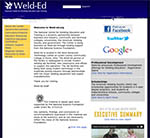Web Content: Reading vs. Skimming
When it comes to website content, there are many approaches for
how to develop material that accurately presents the mission,
goals, and work being done by your project or center, as well as
the ATE community at large. For better or worse, a variety of
readers will visit your website and see your content: those that
don’t read the content but look at images; those that
skim the content; and those who will read every word
on the page. To create content that effectively reaches all facets
of your audience, it’s important to keep these various types in
mind.
While this may seem daunting, keep in mind that content written
for skimmers can actually help all visitors get a sense of
what you’re saying without requiring them to read every word.
Essentially, it enhances the page for readers and doesn’t get in
the way of non-readers. So as you consider adding content,
creating content, and how you would like to display it on your
website, here are some points to consider for making content
skimmable:
-
Place your content where it will be noticed but is not
obtrusive. You might have to break it up a bit. The longer the
content, the more careful you have to be about where and how you
place the content on the page.
-
Start each paragraph with your most important and compelling
verbiage. Many skimmers look only at the first line of each
paragraph. Make it count.
-
Use paragraph/section headings that draw interest but are also
quick to read at a glance. If it’s too long, it gets lost.
-
Use bulleted lists when possible, as this breaks-up the monotony
of the content and creates easy-to-digest chunks.
-
Bold or italicize key concepts throughout, but don’t go
overboard.
-
Add images. Even though images don’t get read, they do draw the
eye and make the content more likely to be seen, skimmed, and
hopefully read.




